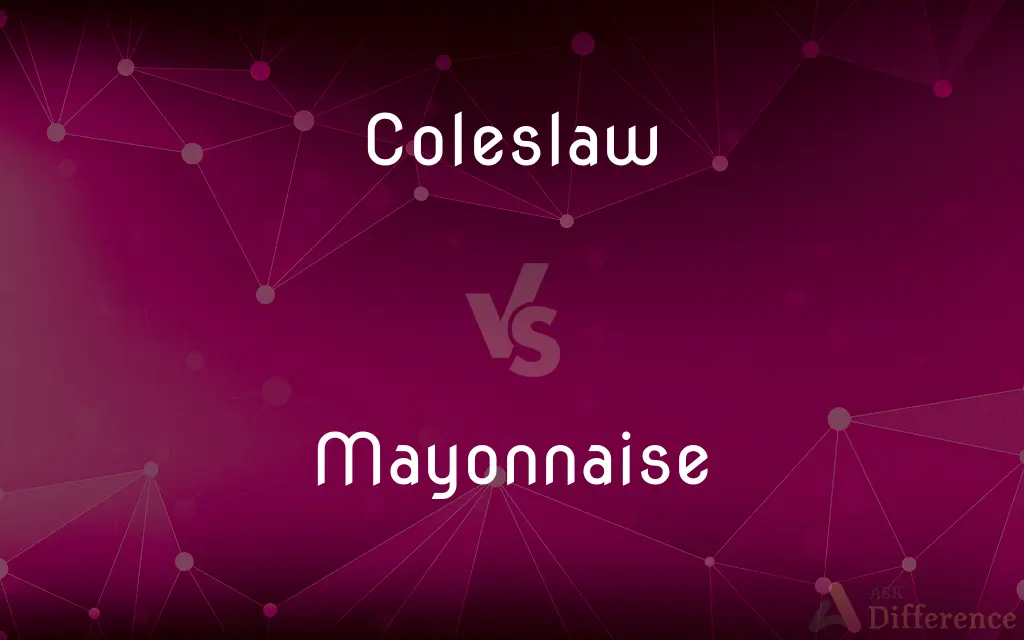Coleslaw vs. Mayonnaise — What's the Difference?
By Urooj Arif & Fiza Rafique — Updated on April 1, 2024
Coleslaw is a salad made from shredded cabbage, sometimes mixed with other vegetables, and dressed commonly in mayonnaise or a vinaigrette, while mayonnaise is a thick, creamy dressing or condiment made from oil, egg yolks, and vinegar or lemon juice.

Difference Between Coleslaw and Mayonnaise
Table of Contents
ADVERTISEMENT
Key Differences
Coleslaw is a popular salad consisting primarily of finely shredded cabbage and often includes other vegetables like carrots or onions. It can be dressed in various ways, though mayonnaise-based dressings are among the most common, contributing to its creamy texture. Mayonnaise, on the other hand, is a condiment created by emulsifying oil, egg yolks, and an acid—either vinegar or lemon juice—along with seasonings. It serves as a base for numerous sauces and dressings, including the dressing often used in coleslaw.
While coleslaw is recognized as a dish or side salad, featuring a combination of raw vegetables with a dressing, mayonnaise stands out as a versatile ingredient or standalone condiment. It's used not only in coleslaw but also in sandwiches, as a dip, and in various other salads, demonstrating its broad utility in culinary applications. The distinction between the two is clear: coleslaw is a prepared food item that may use mayonnaise as a component, whereas mayonnaise is a fundamental culinary ingredient.
The origins and cultural significance of coleslaw and mayonnaise also differ. Coleslaw has roots in Dutch cuisine, originally referred to as "koolsla," meaning "cabbage salad." It has evolved into a staple side dish in many countries, with variations in ingredients and dressings reflecting local tastes. Mayonnaise has its origins in French or Spanish cuisine (the exact origin is debated) and has become a widely used condiment around the world, celebrated for its creamy texture and ability to enhance the flavors of dishes.
In terms of nutritional content, coleslaw can vary widely based on its ingredients and dressing. A mayonnaise-dressed coleslaw is typically higher in calories and fat due to the mayonnaise. Pure mayonnaise is calorie-dense, owing primarily to its oil content, and is rich in fats, including unsaturated fats. The nutritional profile of coleslaw can be adjusted by varying the type and amount of dressing used, making it possible to create lighter versions with less mayonnaise or with alternative dressings.
Finally, the preparation and use of coleslaw versus mayonnaise highlight another difference. Coleslaw is often made by combining shredded cabbage and other vegetables with dressing, and it can be served immediately or allowed to marinate. Mayonnaise, however, is typically made through the process of emulsification, where oil is slowly mixed into egg yolks along with vinegar or lemon juice to create a stable emulsion. This process underscores the technical difference in how each is made and used in cooking and food preparation.
ADVERTISEMENT
Comparison Chart
Composition
Shredded cabbage and vegetables, dressed commonly in mayonnaise or vinaigrette.
Emulsion of oil, egg yolks, and vinegar or lemon juice.
Type
Salad or side dish.
Condiment or dressing.
Uses
Served as a side dish or condiment.
Used in salads, sandwiches, and as a base for other sauces.
Origins
Dutch cuisine, known as "koolsla" (cabbage salad).
Contested between French and Spanish cuisines.
Nutritional Content
Varies widely; can be high in calories and fat if dressed in mayonnaise.
High in calories and fats, primarily unsaturated fats.
Preparation
Mixing shredded vegetables with dressing.
Emulsifying oil into egg yolks and acid.
Compare with Definitions
Coleslaw
A food item with variations reflecting regional tastes.
Her grandmother's coleslaw recipe included unique spices.
Mayonnaise
A base for many other dressings and sauces.
He used mayonnaise to create a homemade garlic aioli.
Coleslaw
A salad made from shredded cabbage, often with a mayonnaise-based dressing.
He enjoyed a side of creamy coleslaw with his barbecue.
Mayonnaise
A thick, creamy condiment made from oil, egg yolks, and an acid.
She spread mayonnaise on her sandwich for extra flavor.
Coleslaw
A dish that can include various vegetables, dressed in mayonnaise or vinaigrette.
The coleslaw featured a tangy vinaigrette that complemented the spicy dishes.
Mayonnaise
A product available in various flavors and formulations.
The vegan mayonnaise was surprisingly similar to the traditional version.
Coleslaw
A salad that can be adjusted for dietary preferences.
They made a low-fat coleslaw by substituting mayonnaise with yogurt.
Mayonnaise
An ingredient that adds moisture and richness to dishes.
Mayonnaise in the cake batter made it exceptionally moist.
Coleslaw
A versatile side that pairs well with a range of main dishes.
Coleslaw is a staple at picnics and cookouts.
Mayonnaise
A condiment with a smooth, stable emulsion.
The chef demonstrated the technique for making perfect mayonnaise from scratch.
Coleslaw
Coleslaw (from the Dutch term koolsla meaning 'cabbage salad'), also known as cole slaw, "New England Salad", or simply slaw, is a side dish consisting primarily of finely shredded raw cabbage with a salad dressing, commonly either vinaigrette or mayonnaise. Coleslaw prepared with vinaigrette may benefit from the long lifespan granted by pickling.
Mayonnaise
Mayonnaise, informally mayo, is a thick cold sauce or dressing commonly used in sandwiches, hamburgers, composed salads, and on French fries. It also forms the base for many other sauces, such as tartar sauce, fry sauce, remoulade, salsa golf and rouille.Mayonnaise is an emulsion of oil, egg yolk, and an acid, either vinegar or lemon juice; there are many variants using additional flavorings.
Coleslaw
A salad of shredded raw cabbage and sometimes shredded carrots, dressed with mayonnaise or a vinaigrette.
Mayonnaise
A thick dressing made of beaten raw egg yolk, oil, lemon juice or vinegar, and seasonings.
Coleslaw
A salad of finely shredded raw cabbage and sometimes shredded carrots, dressed with mayonnaise (white slaw) or a vinaigrette (red slaw).
Mayonnaise
A dressing made from vegetable oil, raw egg yolks, vinegar or lemon juice, and seasoning, used on salads, with french fries, in sandwiches etc.
Coleslaw
A salad made of sliced cabbage.
Mayonnaise
Any cold dish with that dressing as an ingredient.
We served a lobster mayonnaise as a starter.
Hair mayonnaise
Facial mayonnaise
Coleslaw
Basically shredded cabbage
Mayonnaise
(transitive) To cover or season with mayonnaise.
Mayonnaise
A thick white sauce compounded of raw yolks of eggs beaten up with olive oil to the consistency near to that of a gel, and seasoned with vinegar, pepper, salt, etc.; - used in dressing salads, fish, etc. Also, a dish dressed with this sauce.
Mayonnaise
Egg yolks and oil and vinegar
Common Curiosities
Can I substitute mayonnaise in coleslaw with something else?
Yes, alternatives like yogurt, sour cream, or vinaigrette can be used as healthier or lighter options.
How long does homemade mayonnaise last?
Homemade mayonnaise typically lasts for up to one week when stored in a refrigerator.
Can coleslaw be made without mayonnaise?
Yes, coleslaw can be dressed with vinaigrette or other alternatives for a lighter version.
What are the main ingredients in coleslaw?
The main ingredient is cabbage, often accompanied by carrots, onions, and a dressing of mayonnaise or vinaigrette.
Can mayonnaise be used in cooking?
Yes, mayonnaise can be used in cooking for its moisture and flavor, in recipes like cakes or as a base for creamy sauces.
Is coleslaw a healthy side dish?
Coleslaw can be healthy depending on the dressing used; lighter dressings can reduce its calorie and fat content.
Is mayonnaise healthy?
While high in calories and fats, mayonnaise can be part of a balanced diet if consumed in moderation, especially if made with unsaturated fats.
What's the difference between store-bought and homemade mayonnaise?
Homemade mayonnaise often has a fresher taste and can be customized, but store-bought mayonnaise has a longer shelf life and consistent quality.
What makes mayonnaise a stable emulsion?
The lecithin in egg yolks acts as an emulsifier, allowing oil and water (vinegar or lemon juice) to mix and form a stable emulsion.
How can I make my coleslaw more flavorful?
Experimenting with additional ingredients like apple slices, nuts, or using a homemade dressing can enhance the flavor of coleslaw.
Share Your Discovery

Previous Comparison
Accretion vs. Concretion
Next Comparison
Intelligence vs. WitsAuthor Spotlight
Written by
Urooj ArifUrooj is a skilled content writer at Ask Difference, known for her exceptional ability to simplify complex topics into engaging and informative content. With a passion for research and a flair for clear, concise writing, she consistently delivers articles that resonate with our diverse audience.
Co-written by
Fiza RafiqueFiza Rafique is a skilled content writer at AskDifference.com, where she meticulously refines and enhances written pieces. Drawing from her vast editorial expertise, Fiza ensures clarity, accuracy, and precision in every article. Passionate about language, she continually seeks to elevate the quality of content for readers worldwide.















































